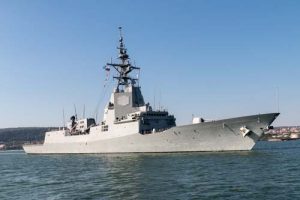Researchers at the U.S. Naval Research Laboratory (NRL) have demonstrated for the first time that they can discover cracks in the ship’s structure by detecting acoustic emission from cracks in riveted lap joints.
Optical Sciences Division, in collaboration with the laboratory’s Material Science Division, used a distributed feedback fiber laser-acoustic emission sensor which showed that the structural health monitoring system works.
The research body said there was currently no other intrinsic optical fiber sensor capable of matching the performance obtained in the laboratory from the fiber laser acoustic emission sensor.
To test the technology, researchers installed the laser sensors into a series of riveted aluminum lap joints and measured acoustic emission over a bandwidth of 0.5 MHz generated during a two-hour accelerated fatigue test. They took equivalent measurements with an electrical sensor.
“An automated, in-situ structural health monitoring (SHM) system, capable of monitoring key structural parameters such as temperature, strain, impacts and cracks, and capable of reliably detecting damage well before reaching a critical level is needed to increase safety and readiness while lowering operational cost of Navy platforms” said Dr. Geoffrey Cranch, research physicist, Optical Sciences Division. “At present, none of the services are using in-situ technologies to manage the structural health of their assets.”
The embedded laser sensors demonstrated acoustic sensitivity comparable to or greater than that achieved by existing electrical sensors. The laser sensors were able to detect low-level acoustic events generated by periodic fretting from the riveted joint, in addition to acoustic emissions from crack formation. Time-lapse imagery of the lap joint revealed that the observed fracture correlated with the signals measured. In addition to crack detection, the fiber laser sensor also showed the ability to measure compromising impacts.
In addition to crack detection, the fiber laser sensor also proved capable of measuring compromising impacts, and the potential to integrate with existing fiber optic strain and temperature sensing systems. Combined, this provides a multi-parameter sensing capability for meeting the full operational safety requirements for an SHM system as well as a significantly lower total ownership costs.
“Our research team has demonstrated the ability of this fiber laser technology to detect acoustic emission at ultrasonic frequencies from cracks generated in a simulated fatigue environment,” Cranch says. “The novel part of this work is the fiber laser technology and how it is being applied.”
Cranch adds that the technology does have possible applications beyond the military. “Our focus is on Navy platforms, such as aircraft, ships and submarines, but the technology could also be used on civilian aircraft,” he said. “Applications to bridges and buildings are also possible if there are critical parts prone to fatigue and failure that would benefit from continuous monitoring.”
As interest in laser detection grows, and your company sees the potential of manufacturing such equipment, UKA will be with you every step of the way in the development of the lens specifically suited to meet the needs with the growing trend. At UKA, we engineer and craft your lens with the precision you would expect from a leader in the industry.
Universe Kogaku designs and manufactures optical lenses for Laser Detection systems, security, high tech and electronic applications. We stock 1000’s of standard lens assemblies and can custom design a solution for scanners, CCTV, CCD/CMOS, medical imaging, surveillance systems, machine vision and night vision systems.